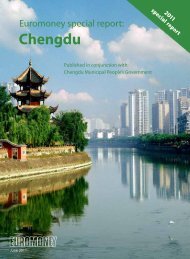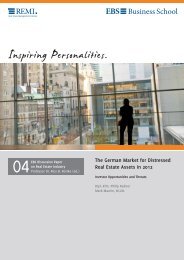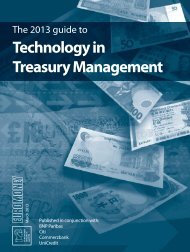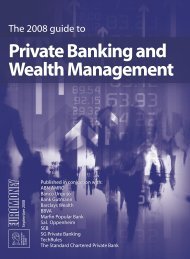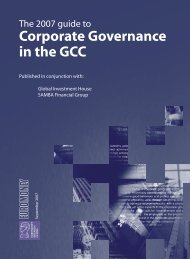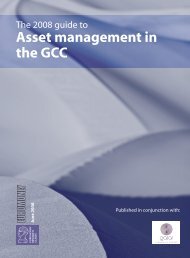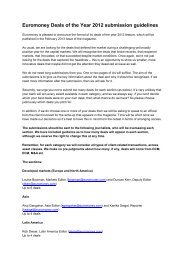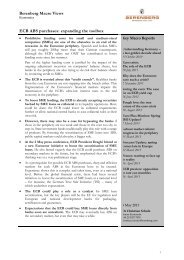Download guide (PDF) - Euromoney
Download guide (PDF) - Euromoney
Download guide (PDF) - Euromoney
You also want an ePaper? Increase the reach of your titles
YUMPU automatically turns print PDFs into web optimized ePapers that Google loves.
The 2012 <strong>guide</strong> to<br />
GLOBAL RISK TRENDS<br />
17<br />
Hungary’s CDS spreads – measuring the<br />
cost of insuring against default - were<br />
trading at 468 basis points at the end<br />
of July, not far off the levels seen in Italy<br />
(489bp), according to data provided by<br />
Markit, the financial information services<br />
company. Hungary has also slipped<br />
down the World Bank’s Doing Business<br />
rankings, due to tighter credit access and<br />
a costlier company tax environment, and<br />
its short-term economic outlook is bleak<br />
- something that ECR contributors have<br />
been aware of for some time as the scores<br />
for the economic-GNP outlook indicator<br />
have fallen. With industrial production<br />
plummeting and business confidence<br />
deteriorating, a 1% contraction in Hungary’s<br />
real GDP is forecast for 2012, according to<br />
the European Bank for Reconstruction<br />
and Development (a 1.5% drop, says the<br />
Organization for Economic Cooperation and<br />
Development).<br />
Hungary’s darkening outlook is summed up<br />
by the International Monetary Fund’s latest<br />
warning, following a staff visit in July: “The<br />
Hungarian economy continues to face a<br />
series of interconnected challenges related<br />
to high public and external indebtedness,<br />
strained bank balance sheets, weak<br />
confidence, and elevated risk perceptions.<br />
Amid a difficult external and domestic<br />
environment, real GDP is expected to<br />
contract in 2012 and recover modestly in<br />
2013. Beyond the current cycle, historically<br />
low levels of private investment and labour<br />
participation cloud the growth outlook.”<br />
Latin worries<br />
And Latin America hasn’t escaped the<br />
global risk aversion, either, even though the<br />
region has performed comparatively better<br />
than the CEE this year. The largest Latin<br />
American countries are among those that<br />
have experienced falls in their ECR bank<br />
stability scores, for instance, contrasting<br />
with smaller countries that have seen an<br />
improvement. Bolivia – an exception to<br />
the rule – has weakened the most, with<br />
a 0.8 point drop in its bank score since<br />
mid-2011, but other countries suffering<br />
from increased bank risk include Argentina,<br />
Brazil, Chile, Colombia and Venezuela – five<br />
of the six largest countries in the region,<br />
measured by GDP. The downgrades in part<br />
reflect susceptibility to increased loan<br />
default following a period of rapid credit<br />
expansion. This has taken place against the<br />
backdrop of a potential shake-out of the<br />
Latin American banking sector, as stronger<br />
regional lenders attempt to gain market<br />
share from Spanish and Portuguese banks<br />
divesting assets - a trend that could persist<br />
if the eurozone crisis worsens.<br />
But bank stability isn’t the only worrying<br />
indicator. In Argentina, the risks of nonpayment/non-repatriation,<br />
information<br />
access/transparency, the country’s<br />
institutions and its regulatory/policy<br />
environment have all deteriorated to<br />
alarmingly low levels. And no wonder.<br />
As reported widely, including in Latin<br />
Finance (‘Argentina Going South’), the<br />
government’s pursuit of nationalization,<br />
through oil company YPF, and other<br />
unorthodox policies – including raising<br />
tariffs, rationing foreign currency to<br />
protect against capital flight, failing to<br />
settle outstanding debts and restricting<br />
dollar-denominated property purchases -<br />
have increased the threat of expropriation,<br />
weakened investor confidence and<br />
exacerbated the uncertainty that is<br />
weighing on the peso. As Richard Segal,<br />
director of emerging markets at Jefferies,<br />
states: “With Buenos Aires running out of<br />
money, the (risk) outlook has been bleak<br />
for some time, but particularly in the<br />
aftermath of YPF.”



